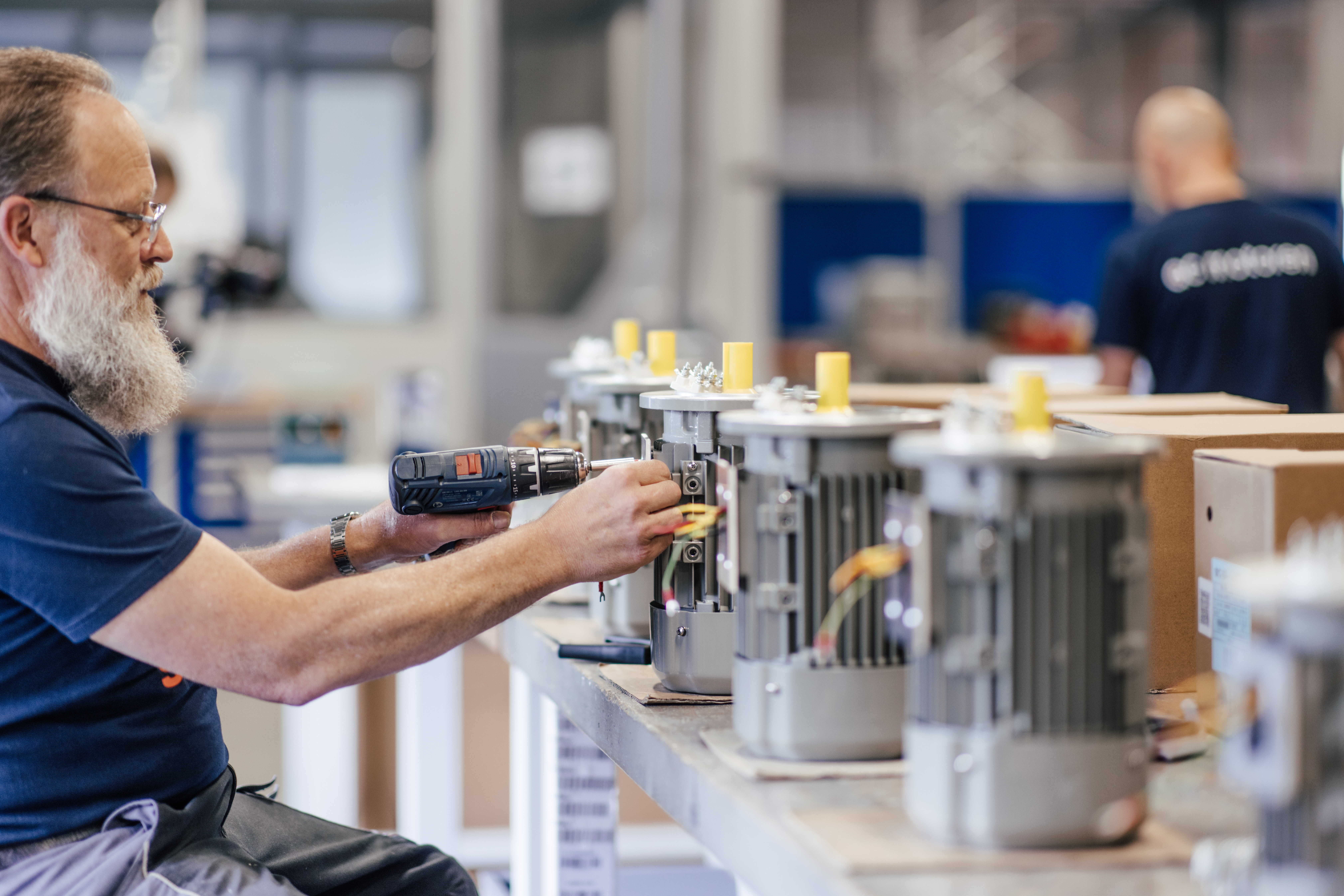PRODUCT KNOWLEDGE
Here you can find out everything you need to know about our motors. If you have a question that we have not listed here, please contact us!
The efficiency class of the motor can be found in the upper right corner of the nameplate, labeled as "IE".
The higher the number, the higher the efficiency of the respective motor.
Energy efficiency class:
IE1 = Standard efficiency
IE2 = High efficiency (HE)
IE3 = Premium efficiency (PHE)
IE4 = Super premium efficiency (SPE)
For more information, click here .
The use of a frequency converter can drastically reduce energy consumption compared to direct mains operation, where the motor runs at full speed regardless of demand. The use of a frequency converter typically results in electricity savings of approximately 40%.
The fundamental difference lies in the power supply.
AC motors are direct current motors, i.e. they are powered by direct current.
DC motors are alternating current motors, i.e. they are powered by alternating current.
The physical operating principle of an electric motor is based on electromagnetic induction and the conversion of electrical energy into mechanical energy – a motor can therefore be described as an energy converter. An electric motor basically consists of two assemblies: the stationary part called the stator and the moving part called the rotor. The purpose of an electric motor is to cause the rotor to rotate. Magnetism forms the basis for this movement. Coils are integrated into both the rotor and the stator. When electricity is applied, magnetic fields are created that attract or repel each other. When this force acts on the rotor – or, to be physically correct, is ‘induced’ – it moves. But only a little bit. This initial movement is the basis of every electric motor.
Our pole-changing motors are designed for operation at two constant speeds, between which it is possible to switch. Typical areas of application include fans and air conditioning units in the ventilation industry. Our two-speed motors are available in all standard designs..
First, the nameplate helps: It shows the rated power (in kW), rated voltage (e.g. 230 VΔ/400 VY), rated speed (rpm), and number of poles. Also pay attention to the mounting type (e.g. B3, B5). Photos are especially helpful — one of the nameplate and one of the entire motor. This gives us both the electrical specifications and mechanical details. You can provide this information (and other values) in your configuration request, and we’ll find the right motor for you!
A PTC thermistor is a small temperature sensor that is built into the motor. Its job is to protect the motor from overheating. If the motor gets too hot, the PTC thermistor significantly changes its electrical resistance – this can be detected by a control system, which switches off the motor before any damage occurs.
You can usually tell whether your motor has a PTC thermistor by checking the following points:
1. Type plate: Look at the metal plate on the motor. It often says something like ‘PTC’, ‘PTC thermistor’, ‘TF’ or something similar.
2. Junction box: If you open the cover of the junction box (only when the power is off!), you will often see extra-thin wires or a separate terminal marked ‘TF’ or ‘T1/T2’.
3. Documentation: The motor's documentation or data sheet often indicates whether a PTC thermistor is installed.
The motors can be modified for installation in hazardous areas in Zone 2 and/or Zone 22.
Zone designations:
- Zone 2 (according to old designation) = II 3G Ex nA II(B, C) T(2, 3, 4)
- Zone 2 (according to new designation) = II 3G Ex ec II(B, C) T(2, 3, 4)
- Zone 22 = II 3D Ex tc III(B, C) T125°C
Higher degrees of protection or other zones can be requested and tested.
Our IEC standard motors are available in all designs according to your requirements. The terminal box is in the ‘top’ position. For motors with aluminium housings, the terminal box position can be changed to the left or right (view of the drive side, also known as the A side). For grey cast iron housings, the terminal box can also be positioned to the side depending on the project. As standard, the terminal box is located ‘close’ to the A-side.
For applications with tight installation conditions, rotating the terminal box can be the solution. The terminal box housing is then ‘close’ to the B side. For motors in aluminium housings, the feet can be screwed on and off as required. For vertical installation (especially outdoors) with the shaft pointing downwards, a protective cover is recommended.
We upgrade your electric motor to climatic conditions of up to 120°C for use at higher ambient temperatures. In addition to selecting the appropriate insulation class H, we configure customised motor protection and ventilation solutions.
The motors are equipped with radial fans made of plastic or aluminium, which cool independently of the direction of rotation of the motor (IC 411 to DIN EN 60034-6). If this cooling is not sufficient, an external fan can be installed.
For your specific application, we can equip your electric motor with an optical or magnetic incremental encoder, or an absolute encoder that provides a precise digital measurement. Due to the wide variety of encoder options, please contact us.
For requirements in areas with dusty air and moisture, we recommend upgrading the IP protection. Our motors are manufactured to IP55 in accordance with DIN EN 60529 as standard. Motors in IP 56, 65 and 66 can be ordered as an option.
We produce special surface finishes, layer thicknesses and colour codes in accordance with RAL to meet your requirements. Coatings can be realised in thicknesses C2, C3, C4 and C5.
Various protective devices are available to protect the motor against thermal overload:
- Thermal resistance in the form of a PTC thermistor (PTC)
- Motor protection switch in the form of a bimetal (PTO) or PT100 / PT1000
Contact us if you require advice or further information on this topic.
The run capacitor (BK) creates a phase shift between the working winding and the auxiliary winding and thus a magnetic field that causes the motor to rotate in the first place. During operation, the run capacitor ensures sufficient torque.
The starting capacitor (AK) is only connected in parallel with the BK during the starting phase in order to provide a higher starting torque. It is switched off by a centrifugal switch or a relay after the motor has started up
Typical signs of a defective capacitor are
- The motor does not start or only hums
- Reduced torque or irregular running
- Visible damage to the capacitor such as bulges or leaking electrolyte
In the delta connection, the end of one phase string is connected to the beginning of the next phase string. The outer conductors (L1, L2, L3) are connected to the respective corner points (U1, V1, W1). This is generally used for motors from 4.0kW, as these have a voltage of 400/690V. In the star connection, the three winding ends are connected together to form a star point. The outer conductors (L1, L2, L3) are connected to the respective other end points (U1, V1, W1). Usually for motors up to 3.0 - 4.0kW, as these have a voltage of 230/400V.
The IEC 60034-30 standard defines efficiency classes for electric motors, with increasing levels of efficiency. IE3 (“Premium Efficiency”) and IE4 (“Super Premium Efficiency”) are the highest classes.
IE4 motors feature optimized construction (improved windings, higher-quality materials, etc.) and consume even less energy than IE3 motors. IE4 motors are particularly effective in continuous operation, where they reduce energy consumption and lower operating costs over time.
The nameplate must state “Ex” followed by the ATEX marking (e.g. Ex d IIB T4 Gb).
You can find the right explosion-proof motor in a similar way to standard motors: power requirement (kW), speed (rpm), voltage (e.g. 400 V), also take into account the correct ATEX marking. The current legal situation obliges the end user of a motor to assess the risk of explosion. Depending on the explosion hazard posed by the application, the necessary marking of the motors used is determined.
Zone 1: is a place in which an explosive atmosphere consisting of a mixture with air of flammable substances in the form of gas, vapor or mist is likely to occur in normal operation.
Zone 2: is a place in which an explosive atmosphere consisting of a mixture with air of flammable substances in the form of gas, vapor or mist is not likely to occur in normal operation but, if it does occur, will persist for a short period only.
Zone 21: is a place in which an explosive atmosphere in the form of a cloud of combustible dust in air is likely to occur in normal operation occasionally.
Zone 22: is a place in which an explosive atmosphere in the form of a cloud of combustible dust in air is not likely to occur in normal operation but, if it does occur, will persist for a short period only.
Ex d: is a type of protection in which the enclosure contains the internal explosion and prevents the transmission of the explosion to the outside.
Ex e: is a type of protection in which additional measures are taken to prevent, with an increased degree of safety, the possibility of impermissibly high temperatures and the occurrence of sparks and arcs inside or on external parts of electrical equipment where these do not occur in normal operation.



